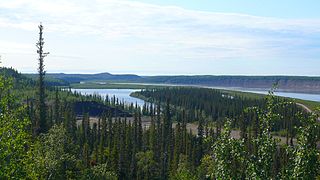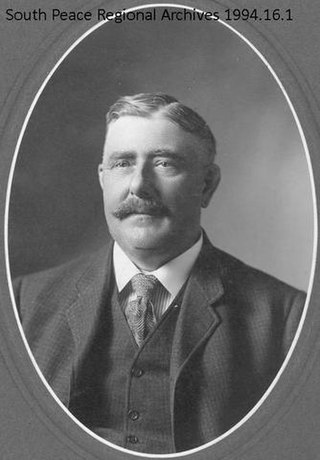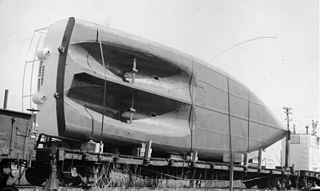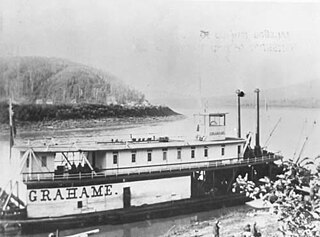Athabasca is an anglicized version of the Cree name for Lake Athabasca in Canada, āthap-āsk-ā-w, meaning "grass or reeds here and there". Most places named Athabasca are found in Alberta, Canada.

The Athabasca River is a river in Alberta, Canada, which originates at the Columbia Icefield in Jasper National Park and flows more than 1,231 km (765 mi) before emptying into Lake Athabasca. Much of the land along its banks is protected in national and provincial parks, and the river is designated a Canadian Heritage River for its historical and cultural importance. The scenic Athabasca Falls is located about 30 km (19 mi) upstream from Jasper.

The Mackenzie River is a river in the Canadian boreal forest. It forms, along with the Slave, Peace, and Finlay, the longest river system in Canada, and includes the second largest drainage basin of any North American river after the Mississippi.

Athabasca, originally named Athabasca Landing, is a town in northern Alberta, Canada. It is located 145 km (90 mi) north of Edmonton at the intersection of Highway 2 and Highway 55, on the banks of the Athabasca River. It is the centre of Athabasca County. It was known as Athabasca Landing prior to August 4, 1913.

The Peace River is a 1,923-kilometre-long (1,195 mi) river in Canada that originates in the Rocky Mountains of northern British Columbia and flows to the northeast through northern Alberta. The Peace River joins the Athabasca River in the Peace-Athabasca Delta to form the Slave River, a tributary of the Mackenzie River. The Finlay River, the main headwater of the Peace River, is regarded as the ultimate source of the Mackenzie River. The combined Finlay–Peace–Slave–Mackenzie river system is the 13th longest river system in the world.

The Slave River is a Canadian river that flows from the confluence of the Rivière des Rochers and Peace River in northeastern Alberta and empties into Great Slave Lake in the Northwest Territories. The river's name is thought to derive from the name for the Slavey group of the Dene First Nations, Deh Gah Got'ine, in the Athabaskan language. The Chipewyan had displaced other native people from this region.

William Fletcher Bredin was a Canadian pioneer businessman and politician. He intermittently farmed and operated businesses in the Canadian West and then served as MLA in the Alberta Legislature.

Lieutenant-Colonel James Kennedy "Peace River Jim" Cornwall was a provincial politician from Alberta, Canada. He served as a member of the Legislative Assembly of Alberta from 1909 to 1913 sitting with the Liberal caucus in government.

The Coquille River starts in the Siskiyou National Forest and flows hundreds of miles through the Coquille Valley on its way to the Pacific Ocean. Bandon, Oregon, sits at the mouth of the Coquille River on the Pacific Ocean. Before the era of railroads and later, automobiles, the steamboats on the Coquille River were the major mode of transportation from Bandon to Coquille and Myrtle Point in southern Coos County, Oregon, United States.

The Rossland was a sternwheel steamboat that ran on the Arrow Lakes in British Columbia. It was named after Rossland, British Columbia, once a prosperous mining town in the region.
The Anglican Diocese of Athabasca is a diocese of the Ecclesiastical Province of Rupert's Land of the Anglican Church of Canada, in the northern half of the civil province of Alberta. It was created in 1874 by the division into four parts of the original Diocese of Rupert's Land. The Synod of the Diocese of Athabasca was organized in 1876. The diocese was then itself subdivided in 1892 to create the new dioceses of Selkirk and Mackenzie River and in 1933 to create the Diocese of The Arctic.

The Mackenzie River in Canada's Northwest Territories is a historic waterway, used for centuries by Indigenous peoples, specifically the Dene, as a travel and hunting corridor. Also known as the Deh Cho, it is part of a larger watershed that includes the Slave, Athabasca, and Peace rivers extending from northern Alberta. In the 1780s, Peter Pond, a trader with the North West Company became the first known European to visit this watershed and begin viable trade with the Athapascan-speaking Dene of these rivers. The Mackenzie River itself, the great waterway extending to the Arctic Ocean, was first put on European maps by Alexander Mackenzie in 1789, the Scottish trader who explored the river. The watershed thus became a vital part of the North American fur trade, and before the advent of the airplane or road networks, the river was the only communication link between northern trading posts and the south. Water travel increased in the late 19th century as traders, dominated primarily by the Hudson's Bay Company (HBC), looked to increase water services in the Mackenzie River District.

Marine Transportation Services (MTS) formerly Northern Transportation Company Limited (NTCL) is a marine transportation company operating primarily in the Mackenzie River watershed of the Northwest Territories and northern Alberta, and the Arctic Ocean using a fleet of diesel tug boats and shallow-draft barges. NTCL filed for bankruptcy in 2016 and its assets were acquired by the Government of the Northwest Territories later that year.

The Radium Express is a Russel Brothers tugboat operated by the Northern Transportation Company. The vessel was built in Owen Sound, Ontario, disassembled, and then shipped by rail to Waterways, Alberta, which was then the terminus of the North American railway grid.

SS Grahame was a wooden sternwheeled steamship built in Fort Chipewyan, District of Athabasca, by the Hudson's Bay Company in 1882–1883 for service on the Athabasca River, lower Peace River, the Clearwater River, and the upper Slave River.

Agnes Deans Cameron was a Canadian educator, writer, journalist, lecturer, and adventurer. She was the first white woman to reach the Arctic Ocean and her published book about the journey was a best-seller. She promoted immigration to Canada through her lectures and publications.

The Athabasca Landing Trail was a long-distance portage route that linked Fort Edmonton on the North Saskatchewan River with Athabasca Landing on the Athabasca River. The distance of the trail between Fort Edmonton and Athabasca Landing was 100 miles (160 km), giving the trail the nickname "The 100 Mile Portage."

The Radium Cruiser was a Russel Brothers tugboat operated on the Mackenzie River system for the "Radium Line". She was constructed in Owen Sound, Ontario, in 1939, then disassembled and shipped by rail to Waterways, Alberta. Waterways is a river port, and was then the northern terminus of the North American railway grid. Waterways is on the Clearwater River, not far upstream from where the river empties into Lake Athabasca. The waters of Lake Athabasca flow into Great Slave Lake down the Slave River, and then down the Mackenzie River to the Arctic Ocean.

Grand Rapids is found 427.4 kilometres (265.6 mi) from the mouth of the Athabasca River, Alberta, Canada.

Northland Echo was a sternwheel steamship operated by the Northern Transportation Company on the Mackenzie River system.


















